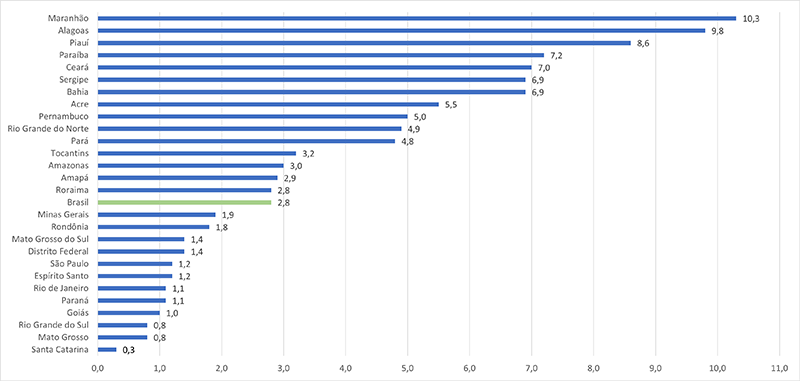Quarterly Continuous PNAD: unemployment increases in 12 of the 27 Federation Units in Q1 2025
May 16, 2025 09h00 AM | Last Updated: May 16, 2025 07h53 PM
The unemployment rate in the country in Q1 2025 (7.0%) increased by 0.8 percentage points (p.p.) against the previous quarter (6.2%) and fell 0.9 p.p. against the same moving quarter in 2024 (7.9%). Fromm Q4 2024, the unemployment rate increased in 12 of the 27 Federation Units and remained stable in the other 15. The highest rates were those of Pernambuco (11.6%), Bahia (10.9%) and Piauí (10.2%), and the lowest were found in Santa Catarina (3.0%), Rondônia (3.1%) and Mato Grosso (3.5%).
The unemployment rate (7.0%) was 5.7% for men and 8.7% for women in Q1 2025. By color or race, this rate was below the national average for white persons (5.6%) and above for black (8.4%) and brown ones (8.0%).
The unemployment rate for persons with incomplete high school education (11.4%) was higher than that for the other levels of schooling analyzed. For people with incomplete higher education, the rate was 7.9%, more than twice as that found for persons with a higher education degree (3.9%).
In Q1 2025, the compound underutilization rate (percentage of unemployed persons, time-related underemployed persons, and in the potential workforce in relation to the extended workforce) was 15.9%. Piauí (34.0%) recorded the highest rate, followed by Bahia and Alagoas (both with 27.5%). The lowest rates were those of Santa Catarina (5.3%), Espírito Santo (7.9%) and Mato Grosso (8.1%).
In the first quarter of 2024, 1.4 million persons had been searching for work for two years or more. This indicator fell 25.6% from Q1 2024, but is still 8.1% above the lowest figure in the series for a first quarter (1.3 million), reached in 2014.
The percentage of discouraged workers (compared to the population in the workforce or discouraged) in the country in the first quarter of 2025 was 2.8%. Maranhão (10.3%), Alagoas (9.8%) and Piauí (8.6%) had the highest percentages of discouraged workers, while the lowest were in Santa Catarina (0.3%), Mato Grosso and Rio Grande do Sul (both with 0.8%).
In Brazil, the percentage of workers with a formal employment contract in the private sector was 74.6%. The highest percentages of workers with a formal employment contract were in Santa Catarina (87.8%), São Paulo (83.4%) and Rio Grande do Sul (81.5%), and the lowest ones were in Maranhão (51.8%), Piauí (52.0%) and Pará (55.1%).
The percentage of self-employed workers was 25.3%. The highest percentages were found in Rondônia (35.6%), Maranhão (32.7%) and Amazonas (31.2%), and the lowest ones, in the Federal District (19.0%), Tocantins (20.6%) and Mato Grosso do Sul (21.2%).
The informality rates for Brazil was 38.0% of the employed population. The highest rates were those of Maranhão (58.4%), Pará (57.5%) and Piauí (54.6%) and the lowest, those of Santa Catarina (25.3%), Federal District (28.2%) and São Paulo (29.3%).
The average real monthly earnings amounted to R$3,410. There was an increase in both comparisons: against the immediately previous quarter (R$3,371) and against the same quarter in 2024 (R$3,279). As for the quarterly and annual comparisons, the Northeast (R$2,383) and the South (R$3,840) had a statistically significant increase in earnings in the Q1 2025, while there was stability in the other Major Regions. The highest average earnings were those in the Central-West (R$3,848), South (R$3,840) and Southeast (R$3,814), while the lowest were in the Northeast (R$2,383) and North (R$2,649).
Against Q4 2024, the unemployment rate increased in 12 of the 27 Federation Units and remained stable in the other 15. The highest rates were those of Pernambuco (11.6%), Bahia (10.9%) and Piauí (10.2%), and the lowest, of Santa Catarina (3.0%), Rondônia (3.1%) and Mato Grosso (3.5%).
Unemployment rate, by Federation Unit, against the previous quarter (%) - Q1 2025
| FU | Q4 2024 | Q1 2025 | status |
|---|---|---|---|
| Piauí | 7.5 | 10.2 | ↑ |
| Amazonas | 8.3 | 10.1 | ↑ |
| Ceará | 6.5 | 8.0 | ↑ |
| Pará | 7.2 | 8.7 | ↑ |
| Pernambuco | 10.2 | 11.6 | ↑ |
| Minas Gerais | 4.3 | 5.7 | ↑ |
| Rio Grande do Norte | 8.5 | 9.8 | ↑ |
| Maranhão | 6.9 | 8.1 | ↑ |
| Rio de Janeiro | 8.2 | 9.3 | ↑ |
| Mato Grosso | 2.5 | 3.5 | ↑ |
| Brazil | 6.2 | 7.0 | ↑ |
| Rio Grande do Sul | 4.5 | 5.3 | ↑ |
| Paraná | 3.3 | 4.0 | ↑ |
| Bahia | 9.9 | 10.9 | → |
| Sergipe | 8,4 | 9,3 | → |
| Federal District | 9.1 | 9.1 | → |
| Alagoas | 8.1 | 8.9 | → |
| Amapá | 8.7 | 8.7 | → |
| Paraíba | 8.4 | 8.7 | → |
| Acre | 7.3 | 8.2 | → |
| Roraima | 6.6 | 7.6 | → |
| Tocantins | 5.1 | 6.4 | → |
| São Paulo | 5.9 | 6.2 | → |
| Goiás | 4.8 | 5.3 | → |
| Espírito Santo | 3.9 | 4.0 | → |
| Mato Grosso do Sul | 3.7 | 4.0 | → |
| Rondônia | 2.8 | 3.1 | → |
| Santa Catarina | 2.7 | 3.0 | → |
Piauí has the highest underutilization rate (34.0%) and Santa Catarina, the lowest (5.3%)
In Q1 2025, the compound underutilization rate was 15.9%. Piauí (34.0%) had the highest rate, followed by Bahia and Alagoas (both with 27.5%). The lowest rates were those of Santa Catarina (5.3%), Espírito Santo (7.9%) and Mato Grosso (8.1%).
Compound underutilization rate by Federation Unit (%) – Q1 2025
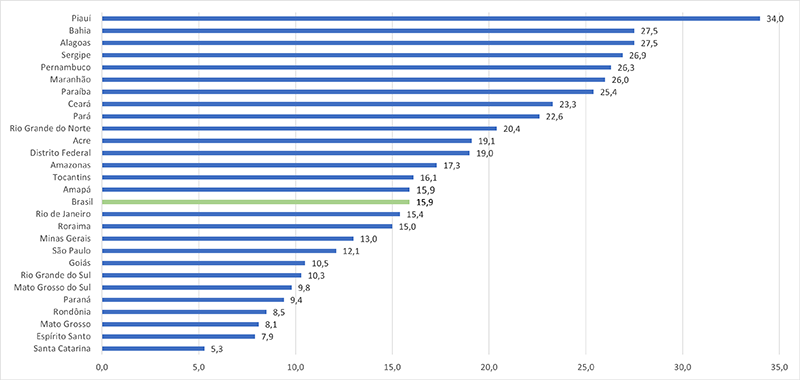 Rondônia has the highest proportion of self-employed workers (35.6%) and the Federal District has the lowest (19.0%)
Rondônia has the highest proportion of self-employed workers (35.6%) and the Federal District has the lowest (19.0%)
The percentage of the self-employed population in the country was 25.3%. The highest percentages were found in Rondônia (35.6%), Maranhão (32.7%) and Amazonas (31.2%), and the lowest ones were in the Federal District (19.0%), Tocantins (20.6%) and Mato Grosso do Sul (21.2%).
Percentage of employed persons, by Federation Unit (%) – Q1 2025
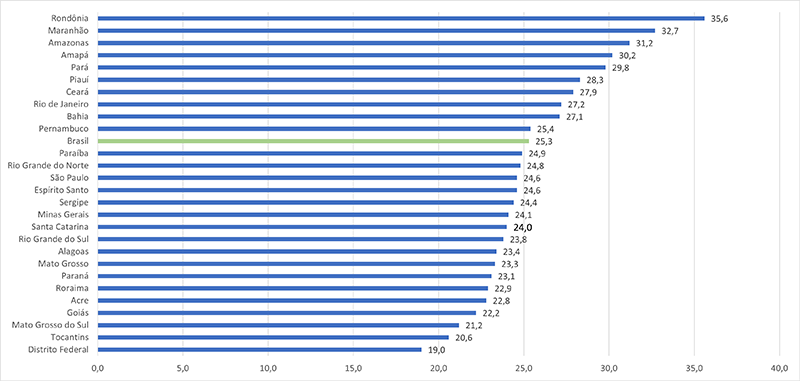
Maranhão has the lowest percentage of workers with a formal employment contract (51.8%) and SC, the highest (87.8%)
In Q1 2025, among workers in the private sector in the country, 74.6% had a formal employment contract. The Federation Units with the highest percentages of workers with a formal employment contract were Santa Catarina (87.8%), São Paulo (83.4%) and Rio Grande do Sul (81.5%), and the lowest were Maranhão (51.8%), Piauí (52.0%), and Pará (55.1%).
Percentage of workers WITH a formal contract in the private sector, by Federation Unit (%) – Q1 2025
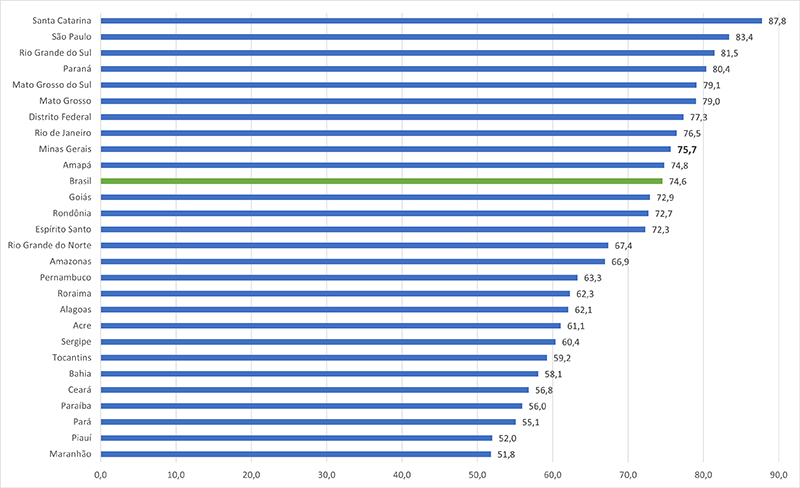
Earnings up only in the South and Northeast
In Q1 2025, the average usual real earnings from all jobs was estimated at R$3,410. There was an increase in both comparisons: against the immediately previous quarter (R$3,371) and against the same quarter in 2024 (R$3,279).
In the quarterly and annual comparisons, the Northeast (R$2,383) and the South (R$3,840) had a statistically significant increase in earnings in Q1 2025, while there was stability in the other Major Regions.
However, real usual earnings (R$ 345.0 billion) remained stable in the quarter and grew 6.6% (R$ 21.2 billion more) in the year.
The Southeast region had the highest real wage bill (R$ 174.9 billion) in Q1 2025. In comparison with Q4 2024, only the South had a statistically significant increase in wage bill, with stability in the remaining Major Regions.
Maranhão (58.4%) has the highest informality rate and Santa Catarina (25.3%) has the lowest
The informality rate for Brazil was 38.0% of the employed population. The highest rates were in Maranhão (58.4%), Pará (57.5%) and Piauí (54.6%) and the lowest ones in Santa Catarina (25.3%), Distrito Federal (28.2%) and São Paulo (29.3%).
Informality rate of the employed population, by Federation Unit (%) – Q1 2025
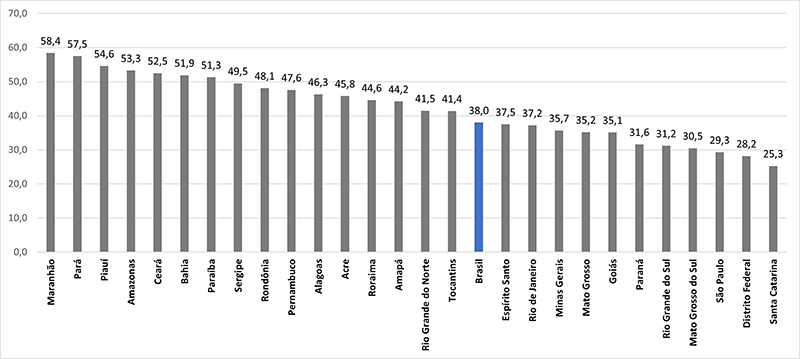
To calculate the informality rate proxy of the employed population, workers in the private sector without a formal employment contract, domestic workers without a formal employment contract, workers without a CNPJ registry, self-employed workers without a CNPJ registry and auxiliary family workers are considered.
Unemployment falls in all job search time ranges compared to the 1st quarter of 2024
In Q1 2025, the number of unemployed persons in the four job search time ranges analyzed by Continuous PNAD fell against the same quarter in the previous year, as shown in the table below.
Furthermore, the number of people who had been searching for work for two years or more fell to 1.4 million, reaching the lowest number of unemployed persons in this range for the first quarter since 2015. Despite the drop of 25.6% from Q1 2024, this figure is still 8.1% above the lowest number for the first quarter in the series (1.3 million), reached in 2014.
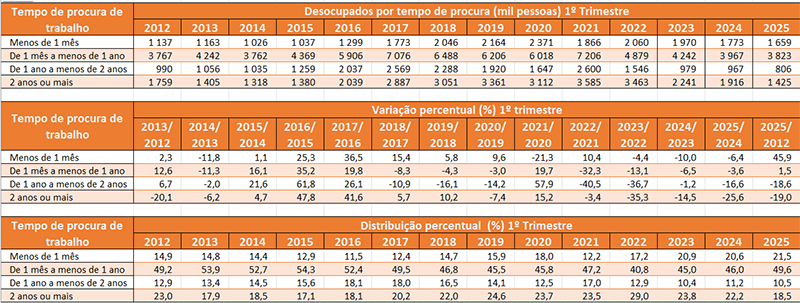
Maranhão has the highest percentage of discouraged workers (10.3%) and Santa Catarina, the lowest (0.3%)
The percentage of discouraged workers (compared to the population in the workforce or discouraged) in the country in Q1 2025 was 2.9%. Maranhão (10.3%), Alagoas (9.8%) and Piauí (8.6%) had the highest percentages of discouraged workers, while the lowest were found in Santa Catarina (0.3%), Mato Grosso and Rio Grande do Sul (both with 0.8%).
Percentage of discouraged persons in workforce or discouraged population (%) - Q1 2025
